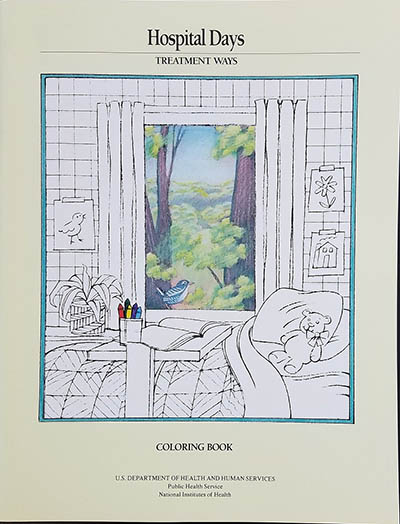From the Annals of NIH History
Glimpses of History through Uniform Patches and Coloring Books
Two New Exhibits at the NIH Clinical Center
Two fairly new exhibits in the NIH Clinical Center (CC)—one on uniform patches and another on coloring books—reveal the more colorful side of the CC’s history.
Patches: Thanks to Margaret Conant (in CC’s Radiological and Imaging Sciences Department), who donated patches to the Office of NIH History and Stetten Museum, more than 50 uniform patches are now on display. You’ll find the exhibit on the first floor of Building 10 at the end of the central corridor near the Phlebotomy/EKG Clinic.

CREDIT: MICHELE LYONS, OFFICE OF NIH HISTORY
Mark Riewestahl, an exhibit intern at the Office of NIH History and Stetten Museum, near the display of Clinical Center patches that he designed.
A familiar sight on lab coats and uniforms, these patches identified different departments and units that operated within the CC. Patches were designed either by the Medical Arts branch or by NIH employees competing in design competitions and revealed the personalities and perspectives of the divisions they represented.
The patches are vibrant, playful, thoughtful, and, at times, mysterious. Anesthesiology’s patch takes the phrase “counting sheep” literally and features two fluffy white sheep leaping over a fence. The patch for the National Cancer Center’s (NCI’s) Hyperthermia Unit shows a crab being boiled, referencing both Maryland’s culinary specialty as well as the zodiac sign Cancer in a clever visual pun. More curiously, though, the CC itself is represented by, of all things, a duck. Why? We’re not quite sure ourselves. Preliminary investigation suggests that it most likely belongs to the genus Aythaya and that it could be a redhead or common pochard. If you have any insights into this mysterious duck’s meaning, please let us know. We’d be delighted to include its history alongside these patches.

CREDIT: MICHELE LYONS, OFFICE OF NIH HISTORY
From left: National Cancer Center’s Hyperthermia Unit patch; Anesthesiology’s patch; and the NIH Clinical Center’s duck patch.
Coloring books: The second exhibit, on the second floor near the cafeteria, considers the history of a familiar object–the coloring book. From explaining the roles of doctors and nurses to illustrating what operating rooms look like, these books not only introduced children to complicated ideas but can also aid historians in understanding changing attitudes and perspectives at the NIH throughout history.

CREDIT: MICHELE LYONS, OFFICE OF NIH HISTORY
One of the coloring books in the display in the NIH Clinical Center: Hospital Days, Treatment Ways: Hematology-Oncology Coloring Book
Coloring books have been prevalent at NIH since at least the 1960s. The oldest on display, The Friendly Clinical Center Coloring Book, introduced children to the NIH and potentially foreign concepts such as medical clothing, hospital rooms, and occupational therapy. Despite the commendable intentions of this coloring book, it unfortunately reveals the biases of the time. Diversity wasn’t a consideration back then—children were all presumed to be white and the doctors exclusively referred to as “men.” This lack of diversity changed, however, with the introduction of The Clinical Center Coloring Book published nearly 30 years later. It was created by Wendy Schubert of the CC’s Patient Education Working Group and represents a more diverse panel of both patients and clinicians. This coloring book, now known as The Clinical Center Patient Coloring Book, is available via the CC’s website.
Another noteworthy coloring book is Hospital Days, Treatment Ways: Hematology-Oncology Coloring Book, written and illustrated by Jenene Warmbier and Ellen Vassy. Warmbier began illustrating the book in 1975 when her two-year-old daughter was diagnosed with a fatal illness—neuroblastoma, a cancer that targets early nerve cells. When her daughter was being treated at the Ohio State University Children’s Hospital (Columbus, Ohio), Warmbier began to draw what she saw around her, compiling images of the potentially scary things that children can encounter during cancer treatment. Using her daughter and her daughter’s friends as models, Warmbier created a remarkably compassionate and friendly image of the hospital featuring a diverse representation of races, sexes, and abilities.
Warmbier was assisted by Ellen Vassy, a nurse at the Children’s Hospital, who contributed text that explained potentially difficult concepts, for both children and parents, such as blood tests and chemotherapy. This book was first used at the Children’s Hospital before being modified and reprinted by NCI in 1982. Written by a loving mother, this coloring book reveals the importance of sharing individual experiences in order to educate and positively affect others and future generations. (Sadly, Warmbier’s daughter died 20 months after her diagnosis.)
These stories and many more are tucked within the halls of the Clinical Center. We invite you to explore these two new exhibits as well as the many others the Office of NIH History and Stetten Museum has installed throughout the NIH campus.
Some of the exhibits in the CC can be found using the CC’s “Take Me There” app. If you have any idea why the CC’s patch is a duck, please contact Michele Lyons at lyonsm@od.nih.gov.
Devon Valera, who has a B.S. in biopsychology from Tufts University (Boston), is a museum educator at the College Park Aviation Museum (College Park, Maryland). In 2020, she volunteered a few hours a week in the Office of NIH History where she helped identify objects in collections to be highlighted for virtual exhibits and researched the history of medical objects, individuals, and laboratories.
This page was last updated on Monday, March 21, 2022
